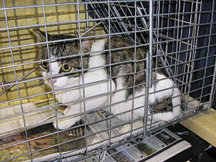Every trash collection night they’re out there, alley cats digging and pawing at garbage bags in search of food. Some residents consider these cats a public nuisance. Others take pity on them, leaving food and water in bowls on the street.
But a growing number of animal welfare activists argue that neither response offers a long-term solution to the problem of feral and free-roaming cats.
Approximately one in every six households in Jersey City is feeding, or helping to feed, homeless cats in the city, one local activist said.
‘They actually have a van called the Neuter Scooter that comes around to pick up the cats.’ – Carol McNichol
____________
It’s a proactive solution that trained residents can use to cut the number of cats living on their streets. But this strategy has caused controversy in some towns where it has been promoted.
Tens of thousands
“There are tens of thousands of cats living on the streets of Jersey City,” said Carol McNichol, founder and president of Companion Animal Trust, a Jersey City-based nonprofit formed to address the problem of stray cats and dogs in Hudson County. “They’ve been living there for years, and they reproduce.”
Nationally, an estimated 90 million cats are living on U.S. streets annually, said McNichol. That translates to about 44,000 cats that could be living in Jersey City alone.
Two years ago Companion Animal Trust launched its Feral Cat Initiative, an annual program that trains residents how to participate in Trap-Neuter-Return (TNR) efforts in their neighborhoods.
Although somewhat controversial, TNR programs are gaining in popularity among many segments of the animal welfare community, largely because such programs rely on spaying and neutering rather than having the animals put to sleep.
“Some cities think that if you just trap a cat and [have it put down] that will fix the problem,” noted McNichol. “Some cities will trap feral cats, take them to a shelter, and have them killed if they aren’t adopted quickly.”
Those programs, she added, emphasize adoption to deal with the homeless cat population. But not every cat will find a loving home. Shelters may find it easy to place kittens in homes. Cats that were socialized as kittens and had human contact before they became homeless may also find it easy to be adopted. However, feral cats – those that were never socialized as kittens – are unlikely to be adopted by families and are much more likely to be put to sleep.
McNichol said that adoption-based programs also don’t help to alleviate the numbers of cats living on the street long-term.
“Cats are territorial. So if you remove every cat in a territory, other cats will come in and take over the territory. You never can get rid of all the cats. And all you need is a couple cats reproducing for a cat colony to [grow again],” she said.
By implementing a TNR program instead, cats within a colony are trapped, neutered/spayed, then returned to their territory. They continue to maintain their territory – but are unable to mate with one another. Over time, the street cat population is significantly reduced.
Some advocate euthanasia
While promoted as an effective “no-kill” feral cat management strategy by many animal welfare groups, conservation organizations and the public health community have not been won over.
Conservationists have argued that feral cats prey on endangered wildlife and their fecal waste can degrade water quality, thus impacting human health. In addition, feral cats often carry diseases that can be spread to domesticated cats and other animals.
These groups argue that feral cats can, and should, be humanely put down to avoid these wider health problems.
Fostering the feral
Through the Feral Cat Initiative, McNichol and Companion Animal Trust have set a goal of trapping and neutering/spaying 400 to 500 cats each year across Hudson County. Most of the group’s work takes place in Jersey City, Bayonne, and Union City – the cities with the highest street cat populations.
Most residents learn about the program through word of mouth and referrals from the Liberty Humane Society, Jersey City’s animal shelter, McNichol said.
Through the initiative, trained residents have been given traps. Tuna, mackerel, and other types of fish are used as bait to lure cats. Residents are then asked to “shelter” the cat for a few days until an appointment can be made for its spaying or neutering. Companion Animal Trust has an arrangement with People for Animals, an animal clinic in Hillside that performs low-cost neutering for $65 and spaying for $70.
“They actually have a van called the Neuter Scooter that comes around to pick up the cats,” McNichol joked.
During their visit to the vet, the animals are also vaccinated against rabies and have one ear clipped slightly to identify them as cats that have been through the TNR program.
After the operation, the resident is then asked to house the animal for several more days while the cat recovers from the surgery. After recover, the animal is returned back into its colony territory.
“The cat never leaves the trap,” McNichol said, adding that residents are trained in how to feed the cat and clean the trap during the shelter period before and after surgery.
Companion Animal Trust has received grants ranging in size from $1,000 to $20,000 to help pay for the cost of the surgeries. The residents who trap and shelter the animals are asked to contribute a $10 copay per cat.
Companion Animal Trust will hold three more TNR training programs this year. The next training workshop will be held on Saturday, Aug. 13. Anyone interested in participating in one of the upcoming sessions is encouraged to call (201) 884-9649.
E-mail E. Assata Wright at awright@hudsonreporter.com.
